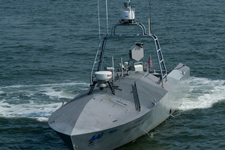redo Jump to...
print Print...

The Navy recently test-fired missiles from a robot boat. Here a common unmanned surface vehicle patrols for intruders during the Trident Warrior 2011 experiment.
(from TechNewsDaily.com) – U.S. Navy ships face the growing threat of small boat swarms used by terrorists, pirates or enemy countries. New testing has shown off a possible counter that looks strangely similar except for the lack of human sailors – small robot boats armed with missiles.
The Navy launched six missiles from an unmanned surface boat – called the unmanned surface vessel precision engagement module (USV PEM) — during testing on Oct. 24. The 36-foot robot boat carries both missiles and a .50 caliber machine gun that can take on small boats that may threaten larger Navy warships.
“Technology demonstrated in this project can provide a capability to combat terrorists who use small low-cost vehicles as weapons platforms,” said Mark Moses, assistant program manager for NAVSEA Naval Special Warfare.
Successful testing could add another weapon to the Navy’s arsenal for countering small boat threats – a terrorist attack used a small boat as a floating suicide bomb to cripple the destroyer USS Cole in 2000. Countries such as Iran have also armed their navies with small boat swarms that can launch missiles or torpedoes in an attempt to overwhelm the defenses of U.S. Navy warships.
The U.S. Navy has previously tried a number of possible defenses against boat swarms, including helicopters armed with homing rockets and shipboard defense turrets that use both lasers and machine guns.
But the latest test using the Navy’s unmanned boat also represents part of a large shift to using robot ships, submarines and flying drones. The Navy has begun experimenting with small drones that could launch from submarine trash disposal chutes along with its large X-47B drone designed to take off from the decks of aircraft carriers.
In the unmanned boat test, Navy operators remotely controlled both the boat and its weapons while launching missiles at moving targets as far away as 2 miles. The Spike missiles, made by the defense company Rafael, represent anti-armor weapons that use electro-optic and infrared sensors to identify targets.
“The fiber optic tether is ultrathin and is spooled up and uncoils automatically during flight,” Moses said. “This allows the operator to view updated targeting information to the missile while it is in flight and to confirm the missile is tracking the intended target up to the moment of impact.”
The testing came as part of a joint counterterrorism project between Israel and the U.S. Navy under the Chief of Naval Operation’s Expeditionary Warfare Division and the Naval Sea Systems Command’s Naval Special Warfare Program Office.
Reprinted here for educational purposes only. May not be reproduced on other websites without permission from TechNewsDaily. Visit the website at technewsdaily.com.
Questions
1. What does the USV have the ability to do?
2. What other possible defenses against boat swarm terrorist attacks has the navy tested?
3. Describe the test conducted on the robot boat at the end of October.
4. What larger project was the test a part of?
5. Do you think the U.S. government (the Obama administration, Congress and military leaders) would order the use of the USV against small boats? Explain your answer.
Daily “Answers” emails are provided for Daily News Articles, Tuesday’s World Events and Friday’s News Quiz.



